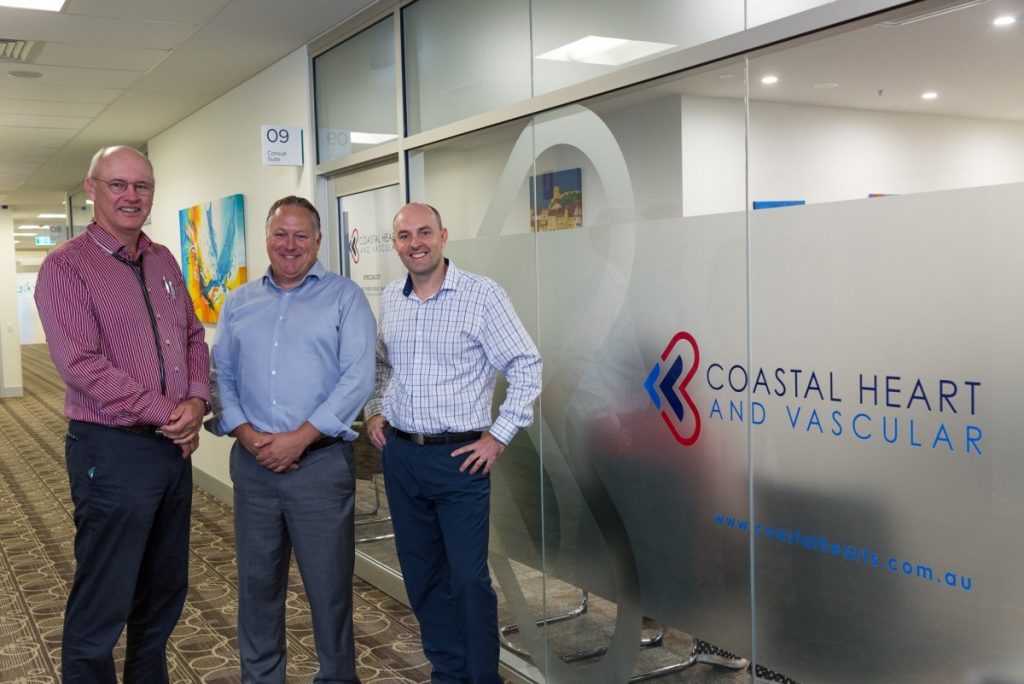A Gold Coast Private cardiologist has made a potentially life saving breakthrough in stroke prevention.
Associate Professor Ross Sharpe and sonographer, Assistant Professor Dan Traves, are the first in Australia to use contrast Trans Cranial Doppler Ultrasound (cTCD) to test if a patient has a Patent Foramen Ovale (PFO). A PFO forms when a connection in the heart that exists in-utero does not close shortly after birth, leaving a flap between the upper chambers of the heart. When the flap fails to close it can result in small clots bypassing the lungs. The clots enter the brain and block the artery, causing a stroke.
“The incidence of PFO is much more prevalent in the younger population than first thought, affecting up to a third of people aged up to 12 years,” said Dr Sharpe.
“If left undetected in a stroke victim, a PFO can lead to further strokes.
“The PFO is also linked to migraines with aura, exertional fatigue and breathlessness, divers decompression illness and altitude sickness, amongst other things.
“Recent studies have revealed that it may be responsible for a lot of diseases that could even shorten our life expectancy.”
Invasive Vs Non-Invasive Stroke Prevention
The accepted gold standard test for PFO detection is a trans-oesophageal echo (TOE). This is where a probe is passed down the throat into the oesophagus to take ultrasound images of the heart. This must be performed under anaesthetic in hospital. Dr Sharpe said this invasive procedure missed up to a 15 per cent of PFO’s – of which 25 per cent were large – while the non-invasive cTCD was 100 per cent accurate in detecting a potential abnormal connection in the heart.
“cTCD is a better, cheaper, safer and quicker test to detect a PFO than the current standard procedure,” said Dr Sharpe.
“A cTCD can be performed in the consulting rooms in less than 15 minutes and involves injecting a saline solution into the blood stream to see if it reaches the brain.
“If it appears in the brain, this would suggest the patient has a PFO.”
Dr Sharpe is not only leading the charge in PFO diagnosis. He is also the Chairman of the PFO Research Foundation. Dr Sharpe has been working on new methods for closure once it has been discovered. He believes closing a PFO can drastically improve, or even save, thousands of lives.
“The non-surgical treatment of PFO complications such as stroke typically involves a life-time of blood thinning medications like Warfarin, but in my experience, closing it is the most effective course of action,” said Dr Sharpe.
“Three highly-regarded studies have recently shown that the hole should be closed and is superior to medication in preventing further brain attacks.
“One study has shown 11 strokes in the medical treatment arm, and none in those treated with a patch – a method used to close a PFO.
“Another study found there was a 400 per cent increased risk of stroke if the patient didn’t have their PFO closed with a patch.”

A Simple, Fast Procedure for Stroke Prevention
Dr Sharpe has developed and altered the techniques to allow for minimally-invasive PFO closure to be done in 20 minutes. This procedure also allows same-day discharge. The method involves local anaesthetic, twilight sedation and locating the hole rapidly with a specially shaped catheter that then allows the patch to be delivered through a 2mm cut in the groin vein with positioning under X-Ray. Dr Sharpe said there were still some in the medical community who didn’t support the procedure. However, the evidence was clearly in favour of closure.
“Unfortunately there is still a long-held belief in the medical community that closing the PFO has few benefits, however the evidence in the literature is now overwhelmingy in favour of closing the hole,” he said.
First Hand Success
Dr Sharpe said studies aside, he had seen the success first-hand.
“My team is now at the point that we are expanding the closure indications to those with severe disabling migraine with aura and who have failed to benefit from usual treatment,” he said.
“Our results have been presented at a major international conference in Europe and we have attracted significant funding for more research. Those studies are about to begin.
“We have seen many patients who have been unable to work or have any kind of meaningful social life due to their severe migraine and following closure they have resumed a normal life.
“Eight years ago there was a young lady who lost her job, her marriage and her baby went into care as she wasn’t able to function due to her headache.
“She travelled the world spending thousands of dollars looking for help before being sent to us where we closed her huge PFO, which had never been picked up.
“The headache disappeared, she started a successful business, and had her child returned to her full-time care.
“I believe we have only scratched the surface of the PFO story and there is potentially many more negative impacts it may be having on the human condition.
“For example we are also investigating the impact of these holes on higher brain functions. Our hypothesis is that the unfiltered blood products may influence the brain neuronal health and even general genomic expression.
“My team will be looking for those factors using advanced analysis of the blood collected at the time of closure.”

Gold Coast Private Hospital
For more information contact: Dr Ross Sharpe, Coastal Hearts and Vascular, Ground Floor, Suite 9, Gold Coast Private Hospital. P: 1300 9 12345, F: 07 5532 9890. Visit the website for the Gold Coast Private Hospital here.
Is that foot pain really affecting you and your daily life? Read our article about how you can get rid of bunions with minimally invasive bunion surgery.

Editor for Silver Magazine Gold Coast

